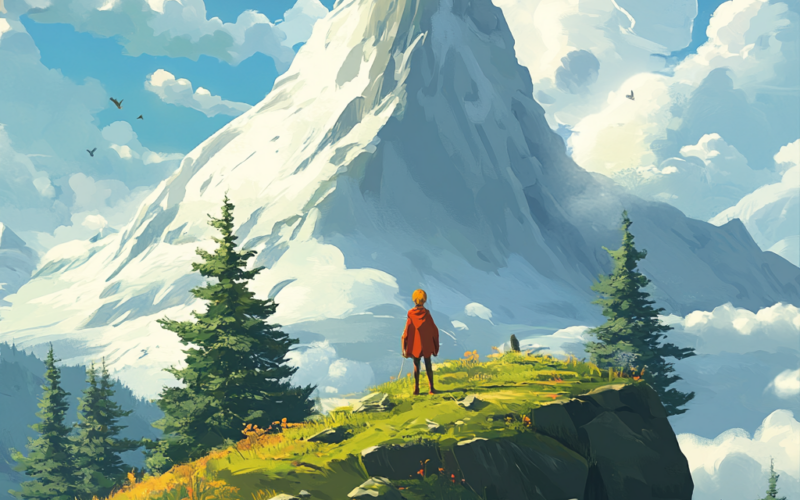Assessing your skills and preparing
Before you start creating illustrations for games, it’s important to objectively assess your current skills. Whether you’re a beginner or have some experience, understanding your strengths and weaknesses will help speed up the learning process. First of all, determine what exactly you need to learn: drawing basics, object modeling, working with textures or animation. This will help you focus on the aspects that are most important to your development as an artist.
The next step is to create a training plan that will include both theoretical and practical components. Reading books, watching online courses and practicing assignments will help strengthen your knowledge. It’s worth starting with basic drawing and digital art techniques to get used to the programs and tools you use. It is important to develop your skills gradually so as not to overload yourself with complex tasks in the early stages.
Selecting Tools and Software
When creating illustrations in the gaming industry, choosing the right tools is key. In the modern world, there are many programs that allow artists and designers to realize their ideas. The most popular among them are Adobe Photoshop, Illustrator, Blender, as well as specialized programs for creating animations, such as Spine or After Effects. The choice of tool depends on your preferences and goals, but it is important to understand that each program has its own characteristics and purpose.
It’s also important to learn the technical features of the programs, such as their ability to work with different file formats, resolutions, and compatibility with other tools. Knowing these details will help you effectively integrate your illustrations into your projects. 3D object modeling programs will also be useful if you plan to create not only 2D images, but also 3D illustrations for games.
Character and Environment Design Basics
Character and environment design is the foundation on which the entire visual style of the game is built. It is important to understand that each element in the game should not only be aesthetically attractive, but also correspond to the overall concept of the project. Creating characters requires a deep understanding of anatomy, emotions, and interaction with the environment. It is important to pay attention to details such as poses, facial expressions and costume features.
In addition to the characters, the design of the environment is of great importance. The environment should not only be functional, but also atmospheric, creating the right atmosphere for the player. It can be a fantasy world or a realistic urban environment. Given the nature of the game, the artist must decide what elements and details to add to create the desired mood. It strongly depends on the genre of the game – for a platformer it will be bright and dynamic scenes, for horror it will be dark and tense landscapes.
Working with colors, textures and lighting
Colors, textures, and lighting are the elements that give a game’s visuals punch and depth. It is important to understand how colors can affect the perception of characters and the world around them.. For example, bright and vibrant colors are often associated with fun and positive play, while dark shades can create a feeling of threat and anxiety. Working with a palette requires knowledge of the psychology of color perception and their harmonious combination.
Textures play an important role in creating realistic objects and scenes. They add detail to the surface and allow objects to look more natural. An important part of the work is also lighting, which helps create volume and depth in 2D or 3D illustrations. Knowing the principles of lighting helps direct the player’s attention to important elements, as well as enhance the atmosphere of the game.
Development of animations and interactions
Once the characters and environments are created, the next step is to add animations and interactions. This not only brings the world to life, but also adds interactivity, which is very important for games. Character animations should be smooth and natural, while objects in the environment should have dynamic reactions to player actions. This could be the animation of a character’s walking, the movement of environmental elements, or the reaction of objects to events in the game.
An important aspect is the interaction of objects with characters and other game elements. Animations can be related to game mechanics such as combat, puzzle solving, or interaction with NPCs. This process requires the artist not only to have skills in creating animation, but also to understand the gameplay goals of the game. Bringing the game world to life makes it more fun and immersive for the player.
Portfolio development and search for freelance projects
To get started in the gaming industry, it is important to create a portfolio that showcases your best work and level of professionalism. A portfolio is your main tool when looking for work or freelance projects. To create a quality portfolio, you need to carefully select projects that best demonstrate your style and ability to work with different techniques. In the early stages, you can add personal projects or works that can show your capabilities and creativity.
After creating a portfolio, you need to start looking for freelance projects. There are platforms like Upwork, Fiverr, Behance and others that help you find clients looking for game illustrators. On these resources you can not only demonstrate your work, but also interact with potential clients by offering your services. This will help you gain experience and increase your reputation, which will later lead to larger and more paid projects.
Here are a few key steps to get started:
- Creating a Portfolio: Include only the best work in your portfolio that reflects your style and skills.
- Using Freelancing Platforms: Sign up for freelancing platforms like Upwork or Fiverr.
- Actively seek projects: Apply to various projects to gain experience and improve your reputation.
- Continuous Improvement: Work to improve the quality of your work and portfolio to attract larger projects.
- Communication with clients: Learn to effectively interact with clients, taking into account their requirements and wishes.
As your career progresses, your portfolio will expand and you will be able to work on more interesting and higher-paying projects. It is important not to stop there and constantly improve your skills, because this will help not only find clients, but also improve your professional level.
Questions and answers
Answer 1: It is important to objectively assess your skills and create a training plan that covers the theoretical and practical aspects.
Answer 2: Popular illustration programs include Adobe Photoshop, Illustrator, Blender, and animation programs such as Spine and After Effects.
Answer 3: The design should not only be aesthetically attractive, but also correspond to the overall concept of the game, creating the right atmosphere.
Answer 4: Colors create atmosphere, and textures add realism to objects and scenes, enhancing the immersion of the game.
Answer 5: A portfolio with the best work and an active search for projects through freelancing platforms are important to gain experience and build a reputation.

